Question on Management 2022
VerifiedAdded on 2022/09/18
|12
|2892
|41
AI Summary
Contribute Materials
Your contribution can guide someone’s learning journey. Share your
documents today.
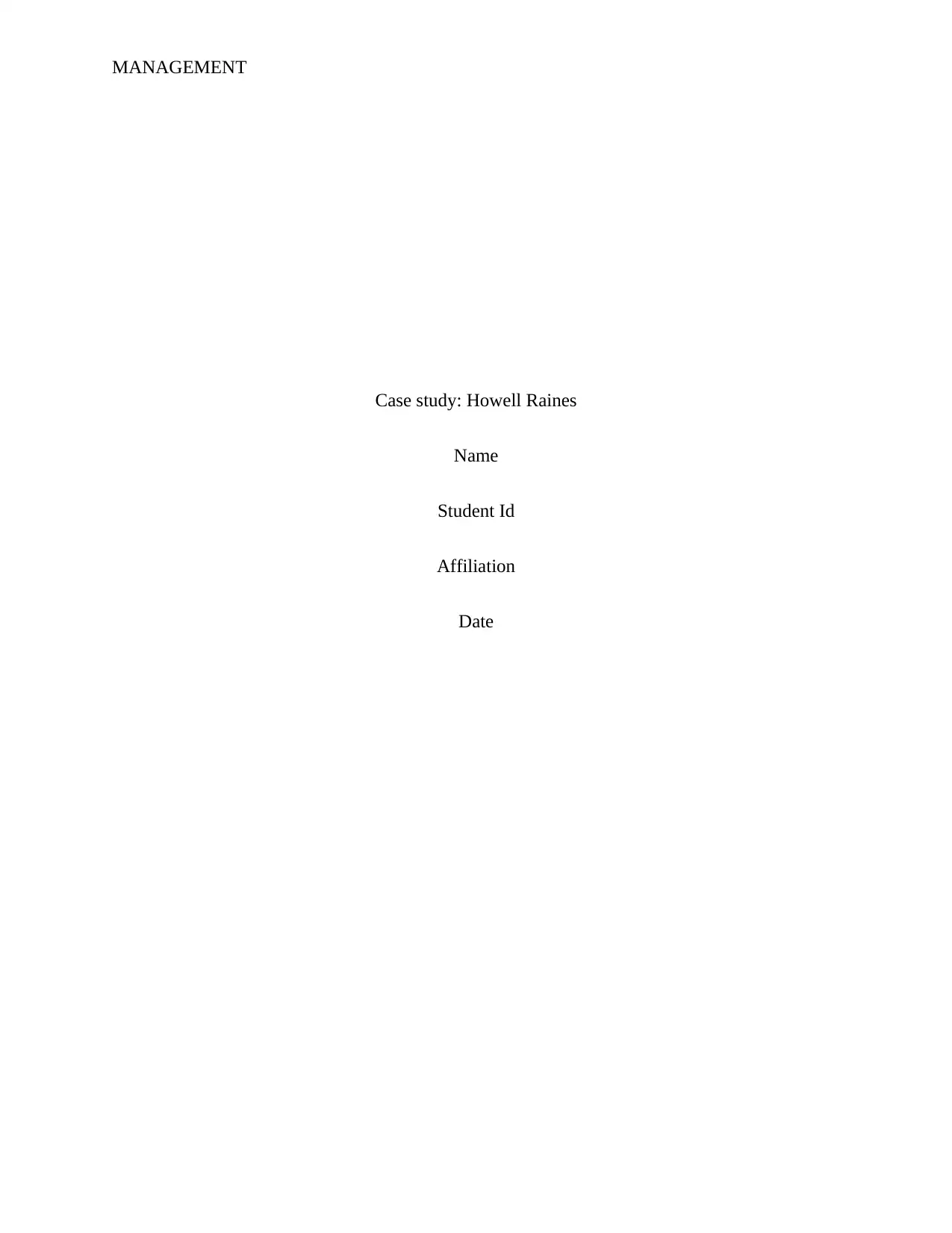
MANAGEMENT
Case study: Howell Raines
Name
Student Id
Affiliation
Date
Case study: Howell Raines
Name
Student Id
Affiliation
Date
Secure Best Marks with AI Grader
Need help grading? Try our AI Grader for instant feedback on your assignments.
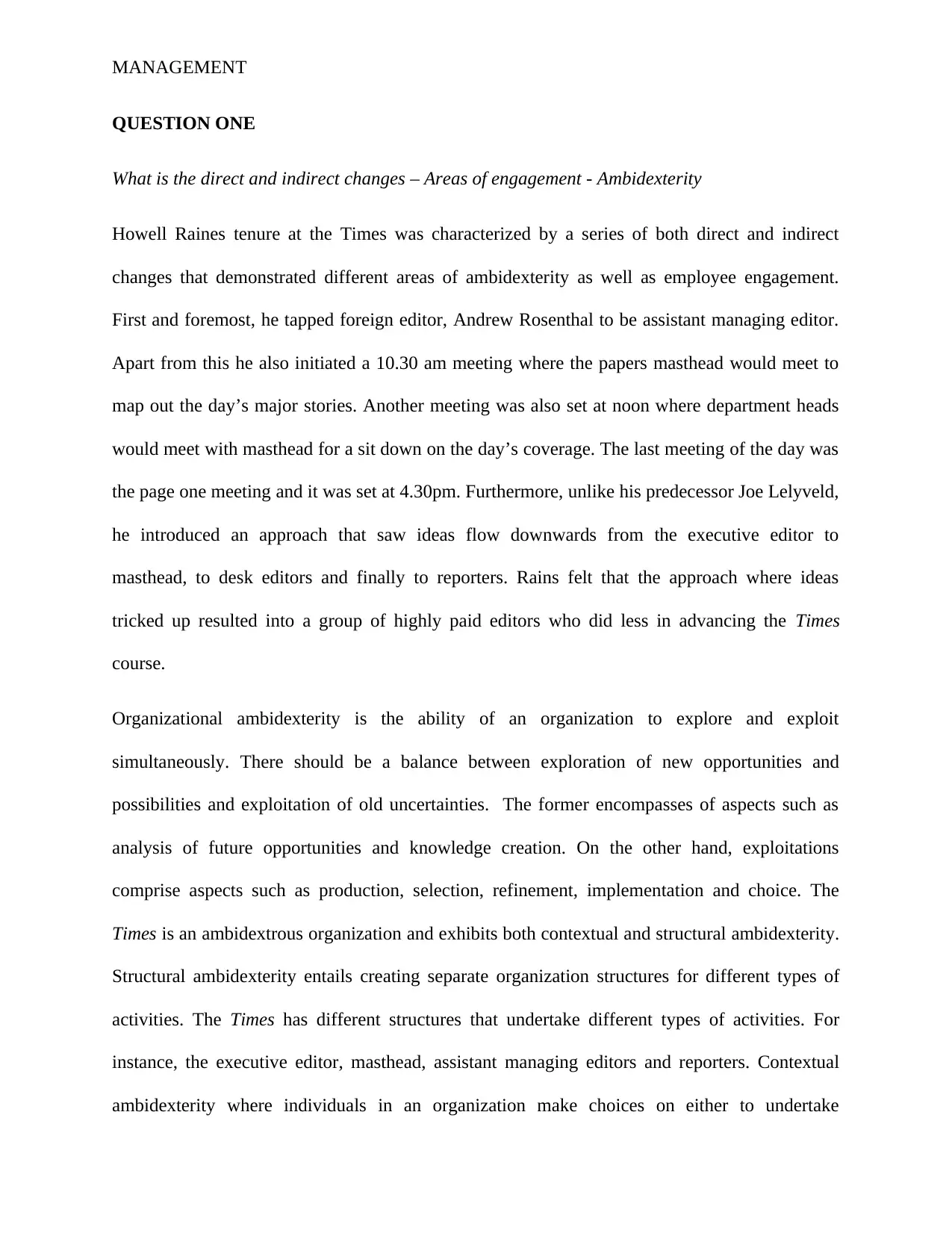
MANAGEMENT
QUESTION ONE
What is the direct and indirect changes – Areas of engagement - Ambidexterity
Howell Raines tenure at the Times was characterized by a series of both direct and indirect
changes that demonstrated different areas of ambidexterity as well as employee engagement.
First and foremost, he tapped foreign editor, Andrew Rosenthal to be assistant managing editor.
Apart from this he also initiated a 10.30 am meeting where the papers masthead would meet to
map out the day’s major stories. Another meeting was also set at noon where department heads
would meet with masthead for a sit down on the day’s coverage. The last meeting of the day was
the page one meeting and it was set at 4.30pm. Furthermore, unlike his predecessor Joe Lelyveld,
he introduced an approach that saw ideas flow downwards from the executive editor to
masthead, to desk editors and finally to reporters. Rains felt that the approach where ideas
tricked up resulted into a group of highly paid editors who did less in advancing the Times
course.
Organizational ambidexterity is the ability of an organization to explore and exploit
simultaneously. There should be a balance between exploration of new opportunities and
possibilities and exploitation of old uncertainties. The former encompasses of aspects such as
analysis of future opportunities and knowledge creation. On the other hand, exploitations
comprise aspects such as production, selection, refinement, implementation and choice. The
Times is an ambidextrous organization and exhibits both contextual and structural ambidexterity.
Structural ambidexterity entails creating separate organization structures for different types of
activities. The Times has different structures that undertake different types of activities. For
instance, the executive editor, masthead, assistant managing editors and reporters. Contextual
ambidexterity where individuals in an organization make choices on either to undertake
QUESTION ONE
What is the direct and indirect changes – Areas of engagement - Ambidexterity
Howell Raines tenure at the Times was characterized by a series of both direct and indirect
changes that demonstrated different areas of ambidexterity as well as employee engagement.
First and foremost, he tapped foreign editor, Andrew Rosenthal to be assistant managing editor.
Apart from this he also initiated a 10.30 am meeting where the papers masthead would meet to
map out the day’s major stories. Another meeting was also set at noon where department heads
would meet with masthead for a sit down on the day’s coverage. The last meeting of the day was
the page one meeting and it was set at 4.30pm. Furthermore, unlike his predecessor Joe Lelyveld,
he introduced an approach that saw ideas flow downwards from the executive editor to
masthead, to desk editors and finally to reporters. Rains felt that the approach where ideas
tricked up resulted into a group of highly paid editors who did less in advancing the Times
course.
Organizational ambidexterity is the ability of an organization to explore and exploit
simultaneously. There should be a balance between exploration of new opportunities and
possibilities and exploitation of old uncertainties. The former encompasses of aspects such as
analysis of future opportunities and knowledge creation. On the other hand, exploitations
comprise aspects such as production, selection, refinement, implementation and choice. The
Times is an ambidextrous organization and exhibits both contextual and structural ambidexterity.
Structural ambidexterity entails creating separate organization structures for different types of
activities. The Times has different structures that undertake different types of activities. For
instance, the executive editor, masthead, assistant managing editors and reporters. Contextual
ambidexterity where individuals in an organization make choices on either to undertake
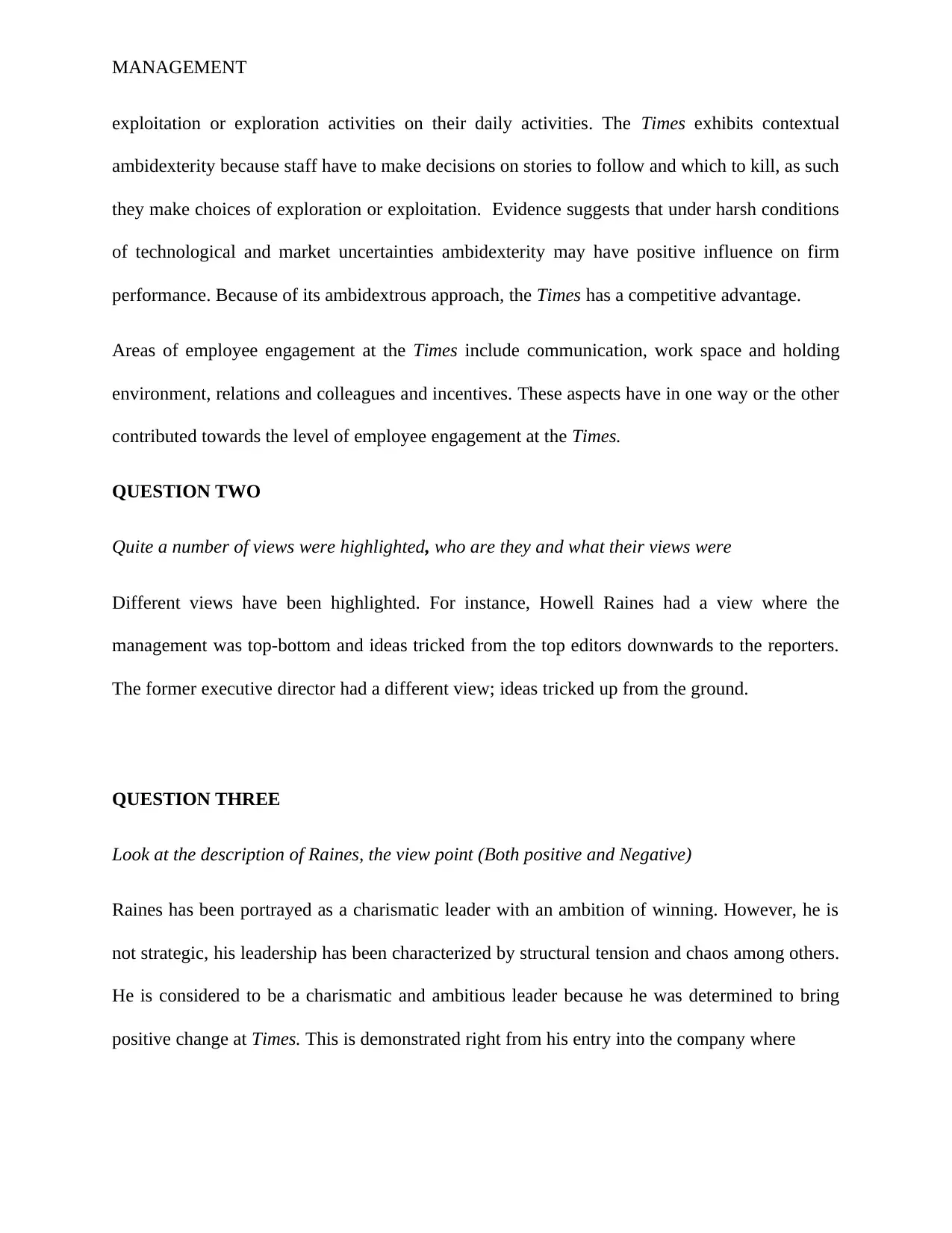
MANAGEMENT
exploitation or exploration activities on their daily activities. The Times exhibits contextual
ambidexterity because staff have to make decisions on stories to follow and which to kill, as such
they make choices of exploration or exploitation. Evidence suggests that under harsh conditions
of technological and market uncertainties ambidexterity may have positive influence on firm
performance. Because of its ambidextrous approach, the Times has a competitive advantage.
Areas of employee engagement at the Times include communication, work space and holding
environment, relations and colleagues and incentives. These aspects have in one way or the other
contributed towards the level of employee engagement at the Times.
QUESTION TWO
Quite a number of views were highlighted, who are they and what their views were
Different views have been highlighted. For instance, Howell Raines had a view where the
management was top-bottom and ideas tricked from the top editors downwards to the reporters.
The former executive director had a different view; ideas tricked up from the ground.
QUESTION THREE
Look at the description of Raines, the view point (Both positive and Negative)
Raines has been portrayed as a charismatic leader with an ambition of winning. However, he is
not strategic, his leadership has been characterized by structural tension and chaos among others.
He is considered to be a charismatic and ambitious leader because he was determined to bring
positive change at Times. This is demonstrated right from his entry into the company where
exploitation or exploration activities on their daily activities. The Times exhibits contextual
ambidexterity because staff have to make decisions on stories to follow and which to kill, as such
they make choices of exploration or exploitation. Evidence suggests that under harsh conditions
of technological and market uncertainties ambidexterity may have positive influence on firm
performance. Because of its ambidextrous approach, the Times has a competitive advantage.
Areas of employee engagement at the Times include communication, work space and holding
environment, relations and colleagues and incentives. These aspects have in one way or the other
contributed towards the level of employee engagement at the Times.
QUESTION TWO
Quite a number of views were highlighted, who are they and what their views were
Different views have been highlighted. For instance, Howell Raines had a view where the
management was top-bottom and ideas tricked from the top editors downwards to the reporters.
The former executive director had a different view; ideas tricked up from the ground.
QUESTION THREE
Look at the description of Raines, the view point (Both positive and Negative)
Raines has been portrayed as a charismatic leader with an ambition of winning. However, he is
not strategic, his leadership has been characterized by structural tension and chaos among others.
He is considered to be a charismatic and ambitious leader because he was determined to bring
positive change at Times. This is demonstrated right from his entry into the company where
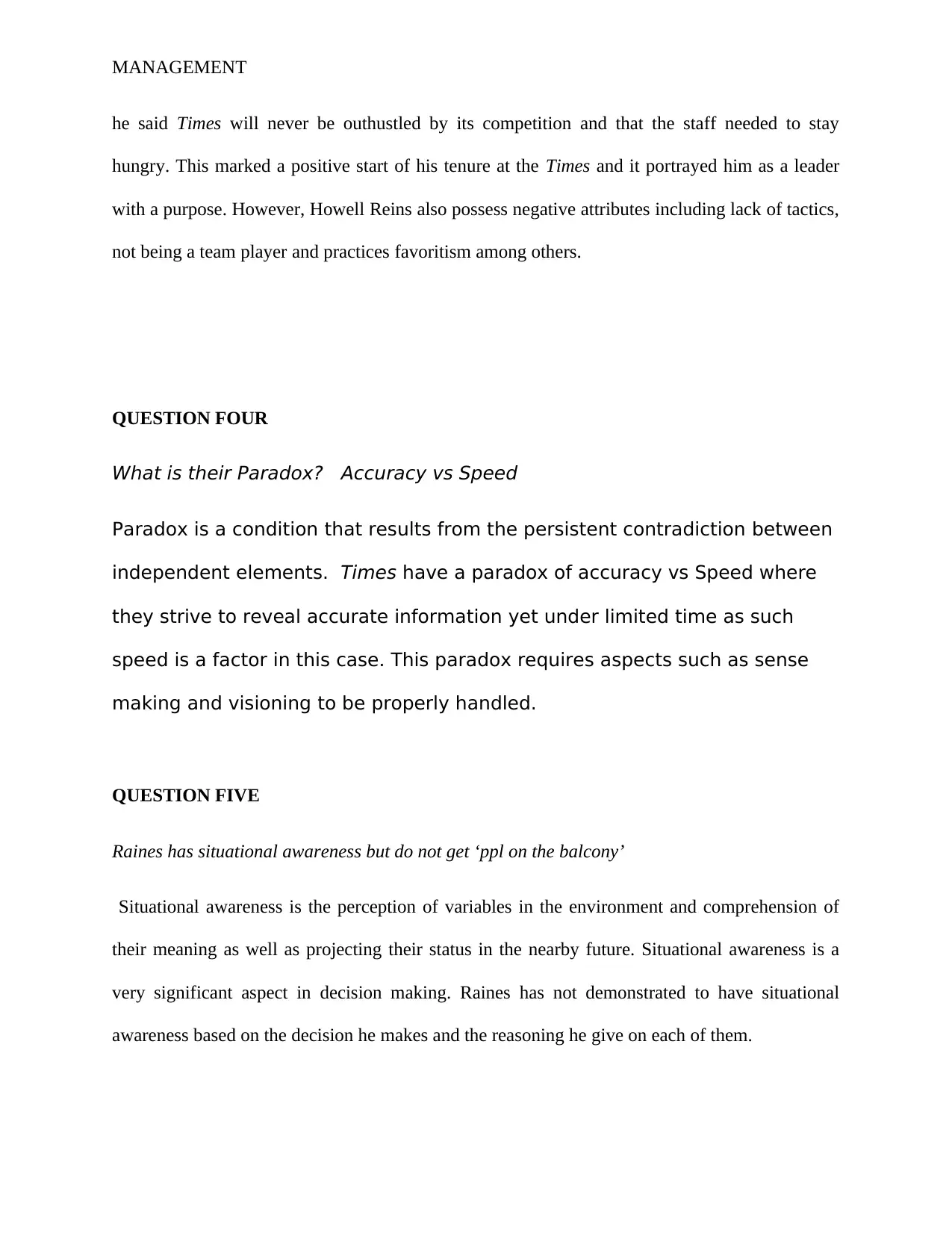
MANAGEMENT
he said Times will never be outhustled by its competition and that the staff needed to stay
hungry. This marked a positive start of his tenure at the Times and it portrayed him as a leader
with a purpose. However, Howell Reins also possess negative attributes including lack of tactics,
not being a team player and practices favoritism among others.
QUESTION FOUR
What is their Paradox? Accuracy vs Speed
Paradox is a condition that results from the persistent contradiction between
independent elements. Times have a paradox of accuracy vs Speed where
they strive to reveal accurate information yet under limited time as such
speed is a factor in this case. This paradox requires aspects such as sense
making and visioning to be properly handled.
QUESTION FIVE
Raines has situational awareness but do not get ‘ppl on the balcony’
Situational awareness is the perception of variables in the environment and comprehension of
their meaning as well as projecting their status in the nearby future. Situational awareness is a
very significant aspect in decision making. Raines has not demonstrated to have situational
awareness based on the decision he makes and the reasoning he give on each of them.
he said Times will never be outhustled by its competition and that the staff needed to stay
hungry. This marked a positive start of his tenure at the Times and it portrayed him as a leader
with a purpose. However, Howell Reins also possess negative attributes including lack of tactics,
not being a team player and practices favoritism among others.
QUESTION FOUR
What is their Paradox? Accuracy vs Speed
Paradox is a condition that results from the persistent contradiction between
independent elements. Times have a paradox of accuracy vs Speed where
they strive to reveal accurate information yet under limited time as such
speed is a factor in this case. This paradox requires aspects such as sense
making and visioning to be properly handled.
QUESTION FIVE
Raines has situational awareness but do not get ‘ppl on the balcony’
Situational awareness is the perception of variables in the environment and comprehension of
their meaning as well as projecting their status in the nearby future. Situational awareness is a
very significant aspect in decision making. Raines has not demonstrated to have situational
awareness based on the decision he makes and the reasoning he give on each of them.
Secure Best Marks with AI Grader
Need help grading? Try our AI Grader for instant feedback on your assignments.
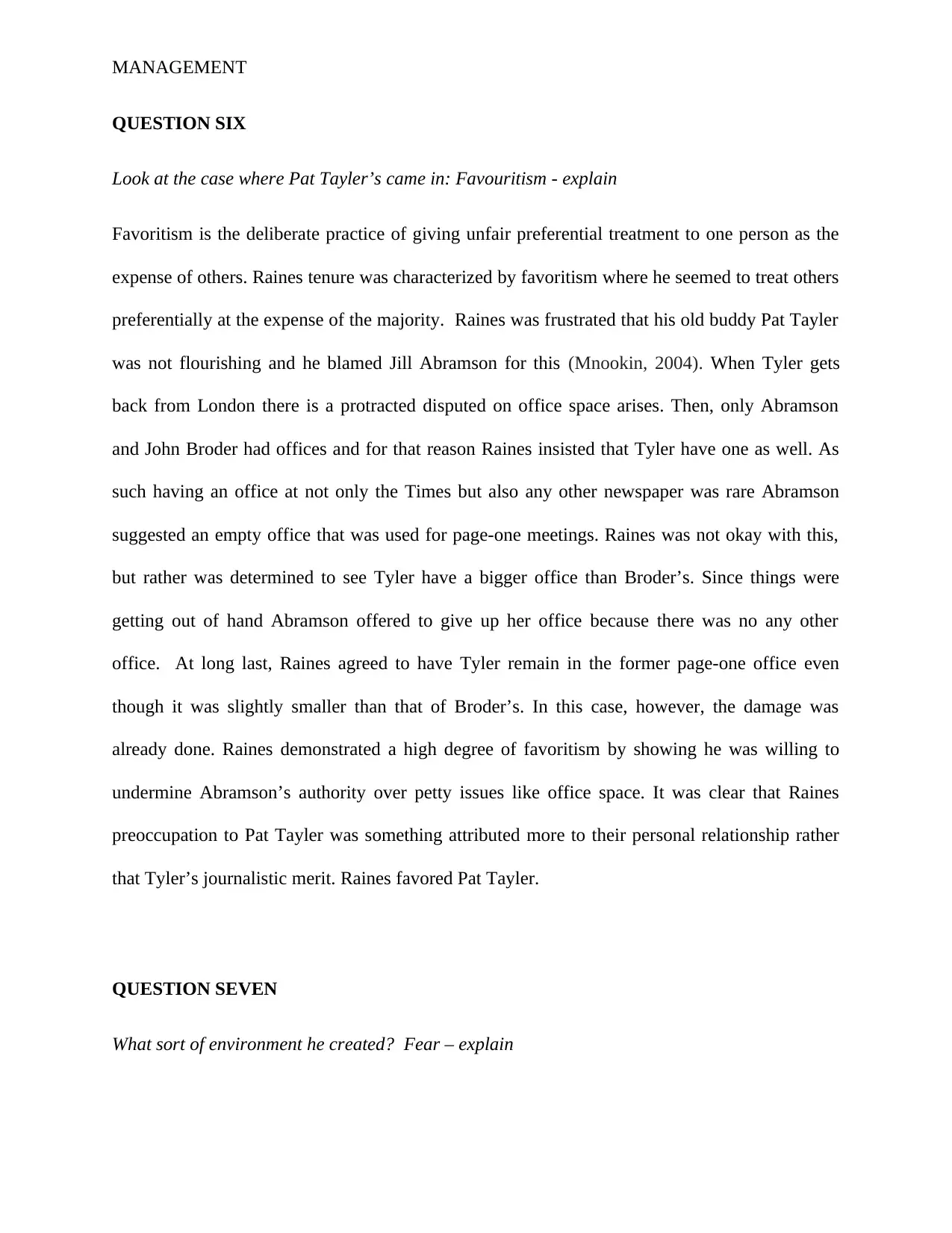
MANAGEMENT
QUESTION SIX
Look at the case where Pat Tayler’s came in: Favouritism - explain
Favoritism is the deliberate practice of giving unfair preferential treatment to one person as the
expense of others. Raines tenure was characterized by favoritism where he seemed to treat others
preferentially at the expense of the majority. Raines was frustrated that his old buddy Pat Tayler
was not flourishing and he blamed Jill Abramson for this (Mnookin, 2004). When Tyler gets
back from London there is a protracted disputed on office space arises. Then, only Abramson
and John Broder had offices and for that reason Raines insisted that Tyler have one as well. As
such having an office at not only the Times but also any other newspaper was rare Abramson
suggested an empty office that was used for page-one meetings. Raines was not okay with this,
but rather was determined to see Tyler have a bigger office than Broder’s. Since things were
getting out of hand Abramson offered to give up her office because there was no any other
office. At long last, Raines agreed to have Tyler remain in the former page-one office even
though it was slightly smaller than that of Broder’s. In this case, however, the damage was
already done. Raines demonstrated a high degree of favoritism by showing he was willing to
undermine Abramson’s authority over petty issues like office space. It was clear that Raines
preoccupation to Pat Tayler was something attributed more to their personal relationship rather
that Tyler’s journalistic merit. Raines favored Pat Tayler.
QUESTION SEVEN
What sort of environment he created? Fear – explain
QUESTION SIX
Look at the case where Pat Tayler’s came in: Favouritism - explain
Favoritism is the deliberate practice of giving unfair preferential treatment to one person as the
expense of others. Raines tenure was characterized by favoritism where he seemed to treat others
preferentially at the expense of the majority. Raines was frustrated that his old buddy Pat Tayler
was not flourishing and he blamed Jill Abramson for this (Mnookin, 2004). When Tyler gets
back from London there is a protracted disputed on office space arises. Then, only Abramson
and John Broder had offices and for that reason Raines insisted that Tyler have one as well. As
such having an office at not only the Times but also any other newspaper was rare Abramson
suggested an empty office that was used for page-one meetings. Raines was not okay with this,
but rather was determined to see Tyler have a bigger office than Broder’s. Since things were
getting out of hand Abramson offered to give up her office because there was no any other
office. At long last, Raines agreed to have Tyler remain in the former page-one office even
though it was slightly smaller than that of Broder’s. In this case, however, the damage was
already done. Raines demonstrated a high degree of favoritism by showing he was willing to
undermine Abramson’s authority over petty issues like office space. It was clear that Raines
preoccupation to Pat Tayler was something attributed more to their personal relationship rather
that Tyler’s journalistic merit. Raines favored Pat Tayler.
QUESTION SEVEN
What sort of environment he created? Fear – explain
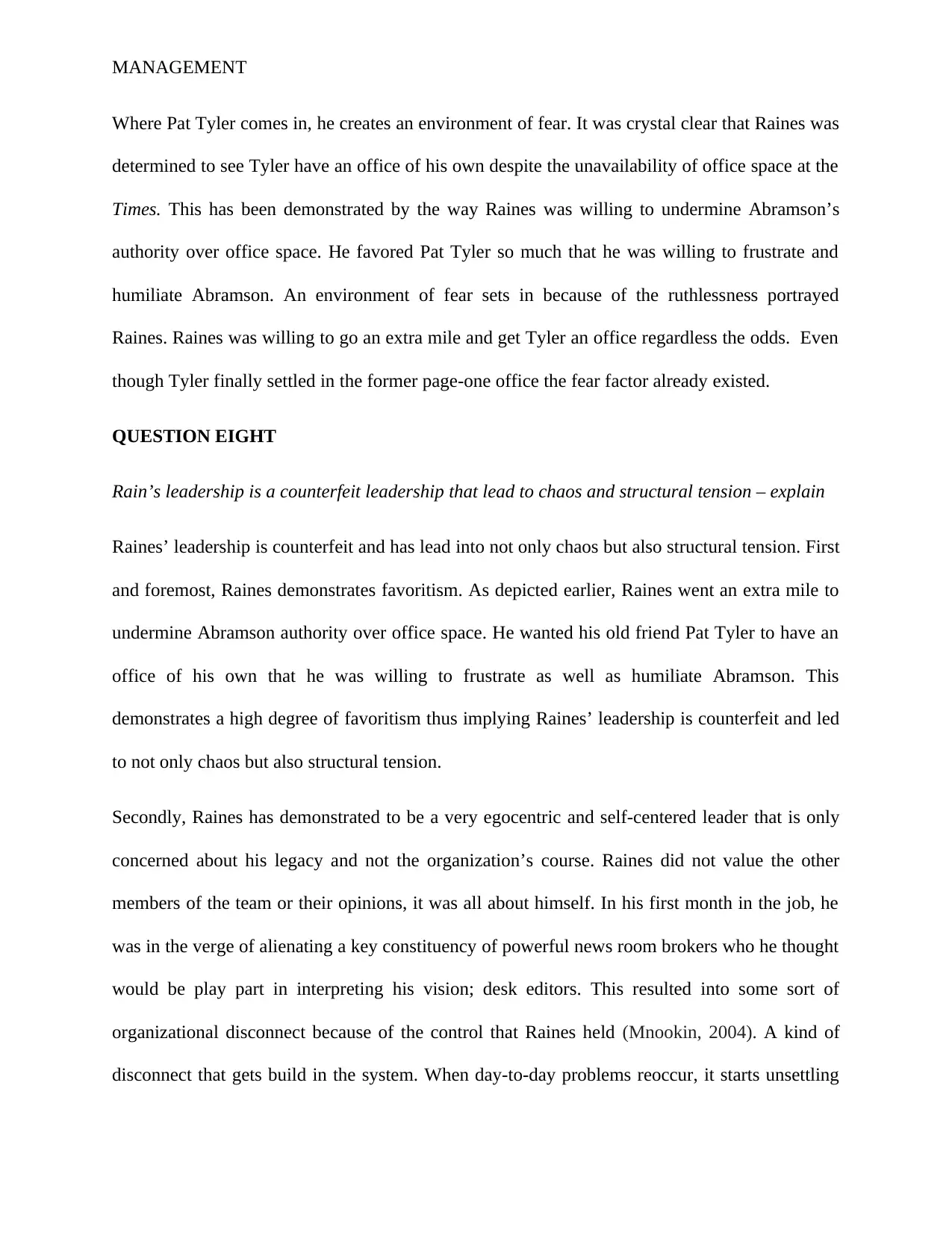
MANAGEMENT
Where Pat Tyler comes in, he creates an environment of fear. It was crystal clear that Raines was
determined to see Tyler have an office of his own despite the unavailability of office space at the
Times. This has been demonstrated by the way Raines was willing to undermine Abramson’s
authority over office space. He favored Pat Tyler so much that he was willing to frustrate and
humiliate Abramson. An environment of fear sets in because of the ruthlessness portrayed
Raines. Raines was willing to go an extra mile and get Tyler an office regardless the odds. Even
though Tyler finally settled in the former page-one office the fear factor already existed.
QUESTION EIGHT
Rain’s leadership is a counterfeit leadership that lead to chaos and structural tension – explain
Raines’ leadership is counterfeit and has lead into not only chaos but also structural tension. First
and foremost, Raines demonstrates favoritism. As depicted earlier, Raines went an extra mile to
undermine Abramson authority over office space. He wanted his old friend Pat Tyler to have an
office of his own that he was willing to frustrate as well as humiliate Abramson. This
demonstrates a high degree of favoritism thus implying Raines’ leadership is counterfeit and led
to not only chaos but also structural tension.
Secondly, Raines has demonstrated to be a very egocentric and self-centered leader that is only
concerned about his legacy and not the organization’s course. Raines did not value the other
members of the team or their opinions, it was all about himself. In his first month in the job, he
was in the verge of alienating a key constituency of powerful news room brokers who he thought
would be play part in interpreting his vision; desk editors. This resulted into some sort of
organizational disconnect because of the control that Raines held (Mnookin, 2004). A kind of
disconnect that gets build in the system. When day-to-day problems reoccur, it starts unsettling
Where Pat Tyler comes in, he creates an environment of fear. It was crystal clear that Raines was
determined to see Tyler have an office of his own despite the unavailability of office space at the
Times. This has been demonstrated by the way Raines was willing to undermine Abramson’s
authority over office space. He favored Pat Tyler so much that he was willing to frustrate and
humiliate Abramson. An environment of fear sets in because of the ruthlessness portrayed
Raines. Raines was willing to go an extra mile and get Tyler an office regardless the odds. Even
though Tyler finally settled in the former page-one office the fear factor already existed.
QUESTION EIGHT
Rain’s leadership is a counterfeit leadership that lead to chaos and structural tension – explain
Raines’ leadership is counterfeit and has lead into not only chaos but also structural tension. First
and foremost, Raines demonstrates favoritism. As depicted earlier, Raines went an extra mile to
undermine Abramson authority over office space. He wanted his old friend Pat Tyler to have an
office of his own that he was willing to frustrate as well as humiliate Abramson. This
demonstrates a high degree of favoritism thus implying Raines’ leadership is counterfeit and led
to not only chaos but also structural tension.
Secondly, Raines has demonstrated to be a very egocentric and self-centered leader that is only
concerned about his legacy and not the organization’s course. Raines did not value the other
members of the team or their opinions, it was all about himself. In his first month in the job, he
was in the verge of alienating a key constituency of powerful news room brokers who he thought
would be play part in interpreting his vision; desk editors. This resulted into some sort of
organizational disconnect because of the control that Raines held (Mnookin, 2004). A kind of
disconnect that gets build in the system. When day-to-day problems reoccur, it starts unsettling
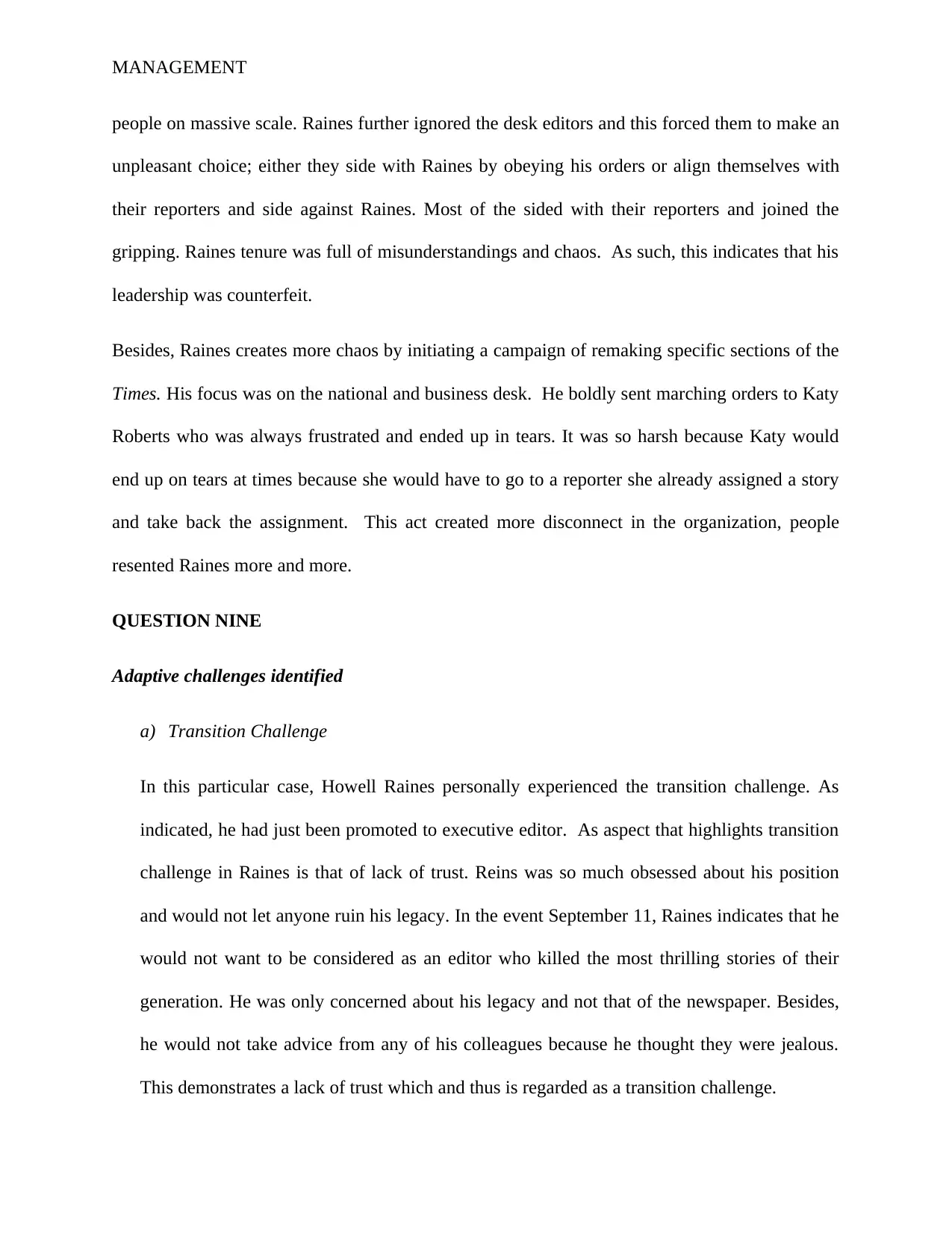
MANAGEMENT
people on massive scale. Raines further ignored the desk editors and this forced them to make an
unpleasant choice; either they side with Raines by obeying his orders or align themselves with
their reporters and side against Raines. Most of the sided with their reporters and joined the
gripping. Raines tenure was full of misunderstandings and chaos. As such, this indicates that his
leadership was counterfeit.
Besides, Raines creates more chaos by initiating a campaign of remaking specific sections of the
Times. His focus was on the national and business desk. He boldly sent marching orders to Katy
Roberts who was always frustrated and ended up in tears. It was so harsh because Katy would
end up on tears at times because she would have to go to a reporter she already assigned a story
and take back the assignment. This act created more disconnect in the organization, people
resented Raines more and more.
QUESTION NINE
Adaptive challenges identified
a) Transition Challenge
In this particular case, Howell Raines personally experienced the transition challenge. As
indicated, he had just been promoted to executive editor. As aspect that highlights transition
challenge in Raines is that of lack of trust. Reins was so much obsessed about his position
and would not let anyone ruin his legacy. In the event September 11, Raines indicates that he
would not want to be considered as an editor who killed the most thrilling stories of their
generation. He was only concerned about his legacy and not that of the newspaper. Besides,
he would not take advice from any of his colleagues because he thought they were jealous.
This demonstrates a lack of trust which and thus is regarded as a transition challenge.
people on massive scale. Raines further ignored the desk editors and this forced them to make an
unpleasant choice; either they side with Raines by obeying his orders or align themselves with
their reporters and side against Raines. Most of the sided with their reporters and joined the
gripping. Raines tenure was full of misunderstandings and chaos. As such, this indicates that his
leadership was counterfeit.
Besides, Raines creates more chaos by initiating a campaign of remaking specific sections of the
Times. His focus was on the national and business desk. He boldly sent marching orders to Katy
Roberts who was always frustrated and ended up in tears. It was so harsh because Katy would
end up on tears at times because she would have to go to a reporter she already assigned a story
and take back the assignment. This act created more disconnect in the organization, people
resented Raines more and more.
QUESTION NINE
Adaptive challenges identified
a) Transition Challenge
In this particular case, Howell Raines personally experienced the transition challenge. As
indicated, he had just been promoted to executive editor. As aspect that highlights transition
challenge in Raines is that of lack of trust. Reins was so much obsessed about his position
and would not let anyone ruin his legacy. In the event September 11, Raines indicates that he
would not want to be considered as an editor who killed the most thrilling stories of their
generation. He was only concerned about his legacy and not that of the newspaper. Besides,
he would not take advice from any of his colleagues because he thought they were jealous.
This demonstrates a lack of trust which and thus is regarded as a transition challenge.
Paraphrase This Document
Need a fresh take? Get an instant paraphrase of this document with our AI Paraphraser
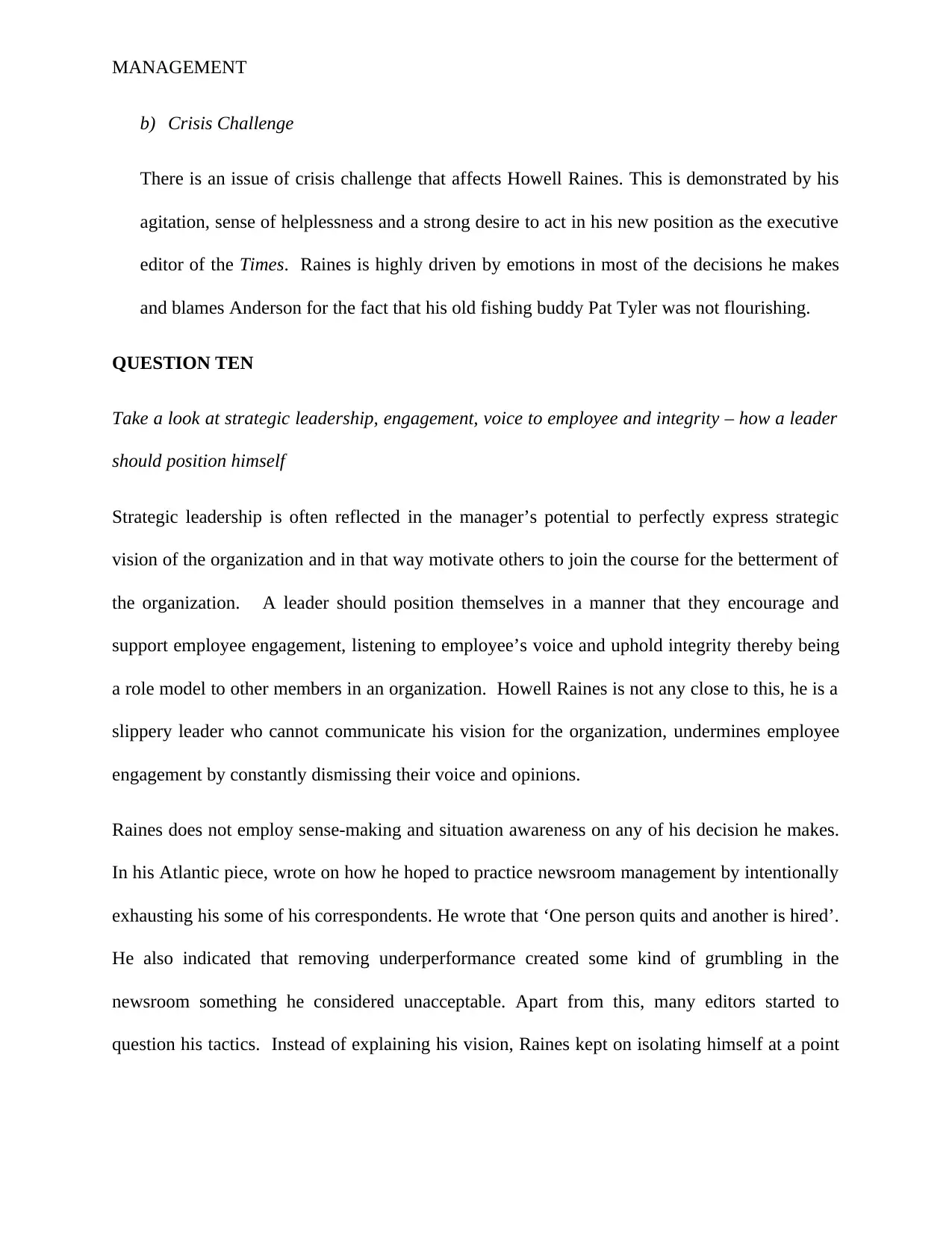
MANAGEMENT
b) Crisis Challenge
There is an issue of crisis challenge that affects Howell Raines. This is demonstrated by his
agitation, sense of helplessness and a strong desire to act in his new position as the executive
editor of the Times. Raines is highly driven by emotions in most of the decisions he makes
and blames Anderson for the fact that his old fishing buddy Pat Tyler was not flourishing.
QUESTION TEN
Take a look at strategic leadership, engagement, voice to employee and integrity – how a leader
should position himself
Strategic leadership is often reflected in the manager’s potential to perfectly express strategic
vision of the organization and in that way motivate others to join the course for the betterment of
the organization. A leader should position themselves in a manner that they encourage and
support employee engagement, listening to employee’s voice and uphold integrity thereby being
a role model to other members in an organization. Howell Raines is not any close to this, he is a
slippery leader who cannot communicate his vision for the organization, undermines employee
engagement by constantly dismissing their voice and opinions.
Raines does not employ sense-making and situation awareness on any of his decision he makes.
In his Atlantic piece, wrote on how he hoped to practice newsroom management by intentionally
exhausting his some of his correspondents. He wrote that ‘One person quits and another is hired’.
He also indicated that removing underperformance created some kind of grumbling in the
newsroom something he considered unacceptable. Apart from this, many editors started to
question his tactics. Instead of explaining his vision, Raines kept on isolating himself at a point
b) Crisis Challenge
There is an issue of crisis challenge that affects Howell Raines. This is demonstrated by his
agitation, sense of helplessness and a strong desire to act in his new position as the executive
editor of the Times. Raines is highly driven by emotions in most of the decisions he makes
and blames Anderson for the fact that his old fishing buddy Pat Tyler was not flourishing.
QUESTION TEN
Take a look at strategic leadership, engagement, voice to employee and integrity – how a leader
should position himself
Strategic leadership is often reflected in the manager’s potential to perfectly express strategic
vision of the organization and in that way motivate others to join the course for the betterment of
the organization. A leader should position themselves in a manner that they encourage and
support employee engagement, listening to employee’s voice and uphold integrity thereby being
a role model to other members in an organization. Howell Raines is not any close to this, he is a
slippery leader who cannot communicate his vision for the organization, undermines employee
engagement by constantly dismissing their voice and opinions.
Raines does not employ sense-making and situation awareness on any of his decision he makes.
In his Atlantic piece, wrote on how he hoped to practice newsroom management by intentionally
exhausting his some of his correspondents. He wrote that ‘One person quits and another is hired’.
He also indicated that removing underperformance created some kind of grumbling in the
newsroom something he considered unacceptable. Apart from this, many editors started to
question his tactics. Instead of explaining his vision, Raines kept on isolating himself at a point
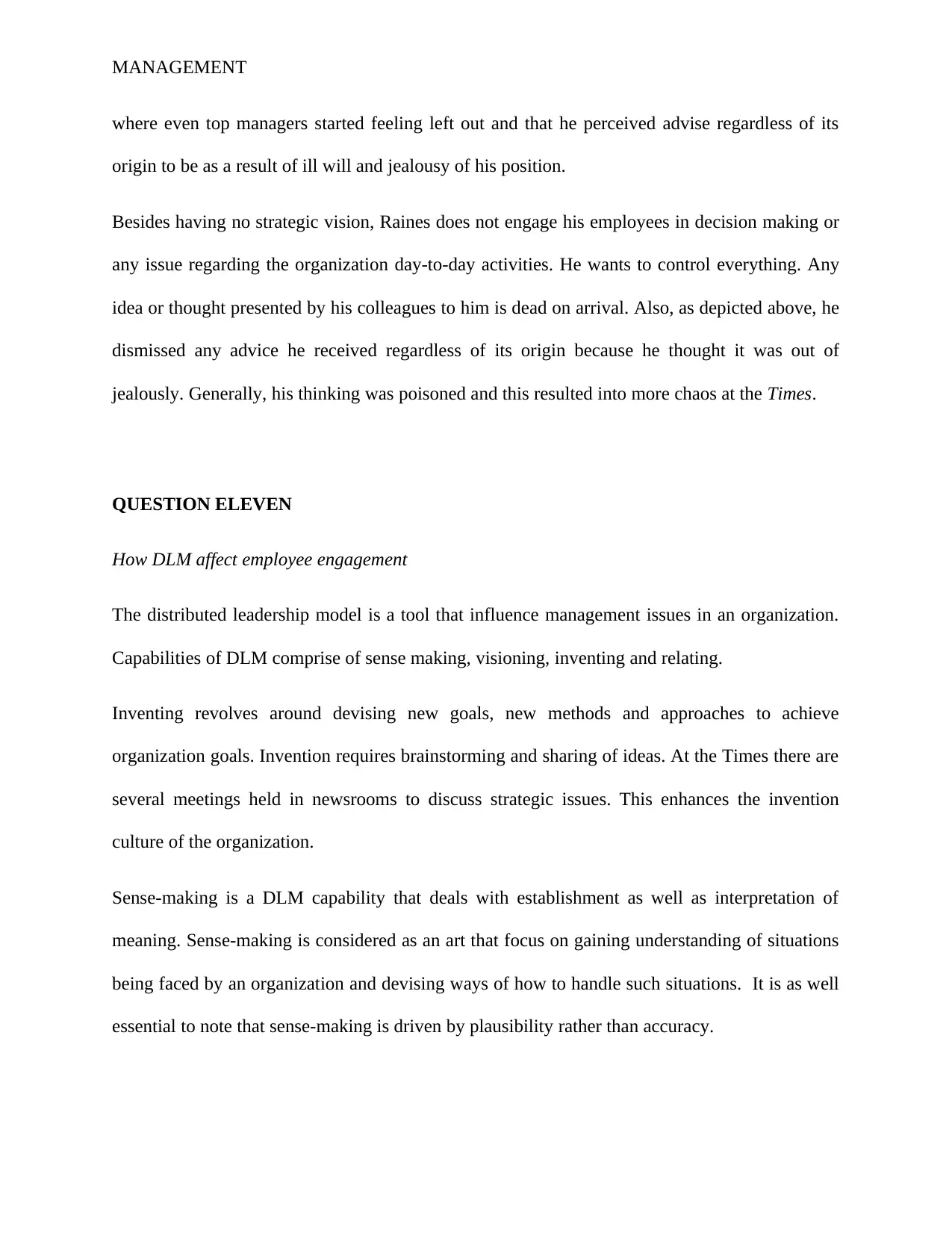
MANAGEMENT
where even top managers started feeling left out and that he perceived advise regardless of its
origin to be as a result of ill will and jealousy of his position.
Besides having no strategic vision, Raines does not engage his employees in decision making or
any issue regarding the organization day-to-day activities. He wants to control everything. Any
idea or thought presented by his colleagues to him is dead on arrival. Also, as depicted above, he
dismissed any advice he received regardless of its origin because he thought it was out of
jealously. Generally, his thinking was poisoned and this resulted into more chaos at the Times.
QUESTION ELEVEN
How DLM affect employee engagement
The distributed leadership model is a tool that influence management issues in an organization.
Capabilities of DLM comprise of sense making, visioning, inventing and relating.
Inventing revolves around devising new goals, new methods and approaches to achieve
organization goals. Invention requires brainstorming and sharing of ideas. At the Times there are
several meetings held in newsrooms to discuss strategic issues. This enhances the invention
culture of the organization.
Sense-making is a DLM capability that deals with establishment as well as interpretation of
meaning. Sense-making is considered as an art that focus on gaining understanding of situations
being faced by an organization and devising ways of how to handle such situations. It is as well
essential to note that sense-making is driven by plausibility rather than accuracy.
where even top managers started feeling left out and that he perceived advise regardless of its
origin to be as a result of ill will and jealousy of his position.
Besides having no strategic vision, Raines does not engage his employees in decision making or
any issue regarding the organization day-to-day activities. He wants to control everything. Any
idea or thought presented by his colleagues to him is dead on arrival. Also, as depicted above, he
dismissed any advice he received regardless of its origin because he thought it was out of
jealously. Generally, his thinking was poisoned and this resulted into more chaos at the Times.
QUESTION ELEVEN
How DLM affect employee engagement
The distributed leadership model is a tool that influence management issues in an organization.
Capabilities of DLM comprise of sense making, visioning, inventing and relating.
Inventing revolves around devising new goals, new methods and approaches to achieve
organization goals. Invention requires brainstorming and sharing of ideas. At the Times there are
several meetings held in newsrooms to discuss strategic issues. This enhances the invention
culture of the organization.
Sense-making is a DLM capability that deals with establishment as well as interpretation of
meaning. Sense-making is considered as an art that focus on gaining understanding of situations
being faced by an organization and devising ways of how to handle such situations. It is as well
essential to note that sense-making is driven by plausibility rather than accuracy.
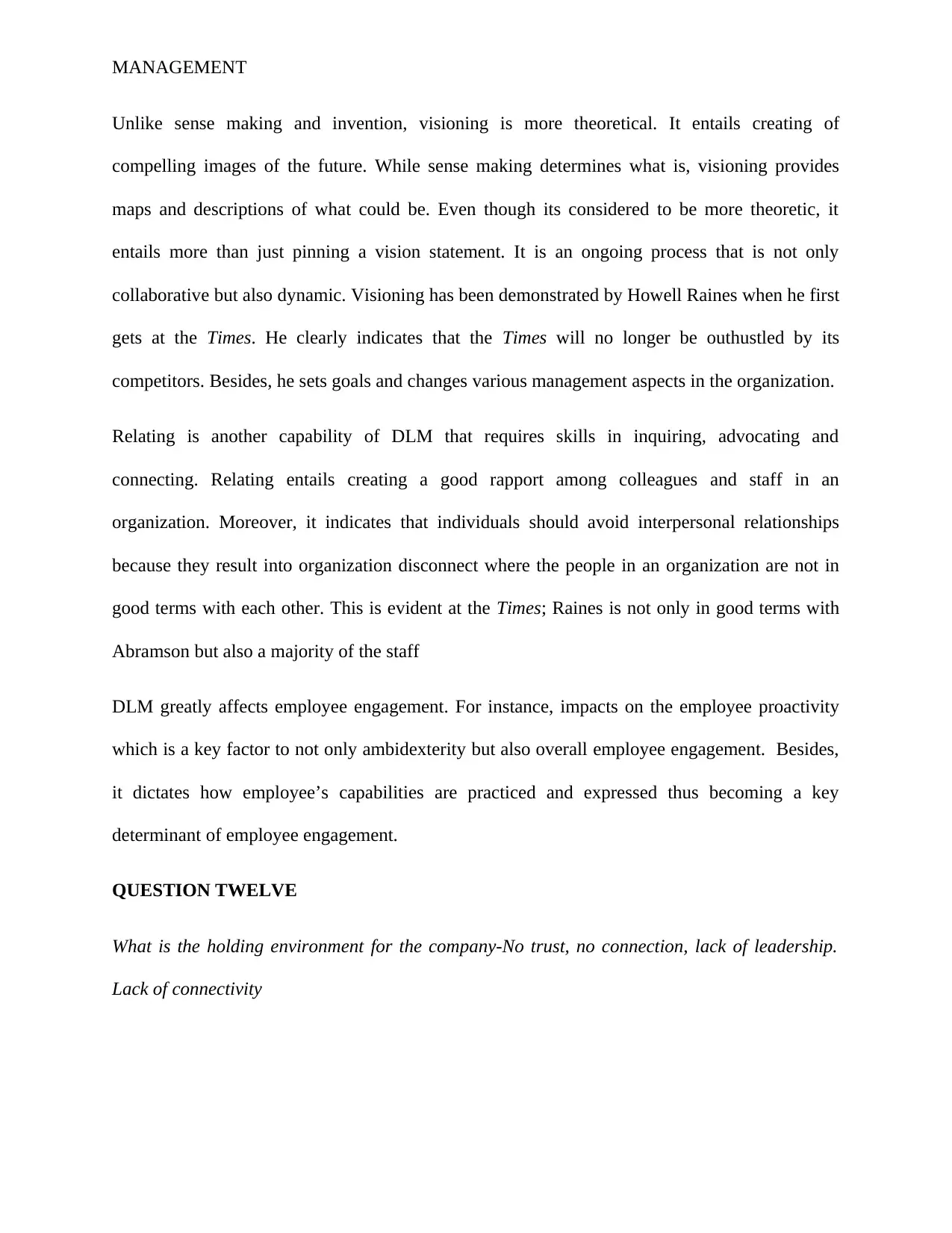
MANAGEMENT
Unlike sense making and invention, visioning is more theoretical. It entails creating of
compelling images of the future. While sense making determines what is, visioning provides
maps and descriptions of what could be. Even though its considered to be more theoretic, it
entails more than just pinning a vision statement. It is an ongoing process that is not only
collaborative but also dynamic. Visioning has been demonstrated by Howell Raines when he first
gets at the Times. He clearly indicates that the Times will no longer be outhustled by its
competitors. Besides, he sets goals and changes various management aspects in the organization.
Relating is another capability of DLM that requires skills in inquiring, advocating and
connecting. Relating entails creating a good rapport among colleagues and staff in an
organization. Moreover, it indicates that individuals should avoid interpersonal relationships
because they result into organization disconnect where the people in an organization are not in
good terms with each other. This is evident at the Times; Raines is not only in good terms with
Abramson but also a majority of the staff
DLM greatly affects employee engagement. For instance, impacts on the employee proactivity
which is a key factor to not only ambidexterity but also overall employee engagement. Besides,
it dictates how employee’s capabilities are practiced and expressed thus becoming a key
determinant of employee engagement.
QUESTION TWELVE
What is the holding environment for the company-No trust, no connection, lack of leadership.
Lack of connectivity
Unlike sense making and invention, visioning is more theoretical. It entails creating of
compelling images of the future. While sense making determines what is, visioning provides
maps and descriptions of what could be. Even though its considered to be more theoretic, it
entails more than just pinning a vision statement. It is an ongoing process that is not only
collaborative but also dynamic. Visioning has been demonstrated by Howell Raines when he first
gets at the Times. He clearly indicates that the Times will no longer be outhustled by its
competitors. Besides, he sets goals and changes various management aspects in the organization.
Relating is another capability of DLM that requires skills in inquiring, advocating and
connecting. Relating entails creating a good rapport among colleagues and staff in an
organization. Moreover, it indicates that individuals should avoid interpersonal relationships
because they result into organization disconnect where the people in an organization are not in
good terms with each other. This is evident at the Times; Raines is not only in good terms with
Abramson but also a majority of the staff
DLM greatly affects employee engagement. For instance, impacts on the employee proactivity
which is a key factor to not only ambidexterity but also overall employee engagement. Besides,
it dictates how employee’s capabilities are practiced and expressed thus becoming a key
determinant of employee engagement.
QUESTION TWELVE
What is the holding environment for the company-No trust, no connection, lack of leadership.
Lack of connectivity
Secure Best Marks with AI Grader
Need help grading? Try our AI Grader for instant feedback on your assignments.
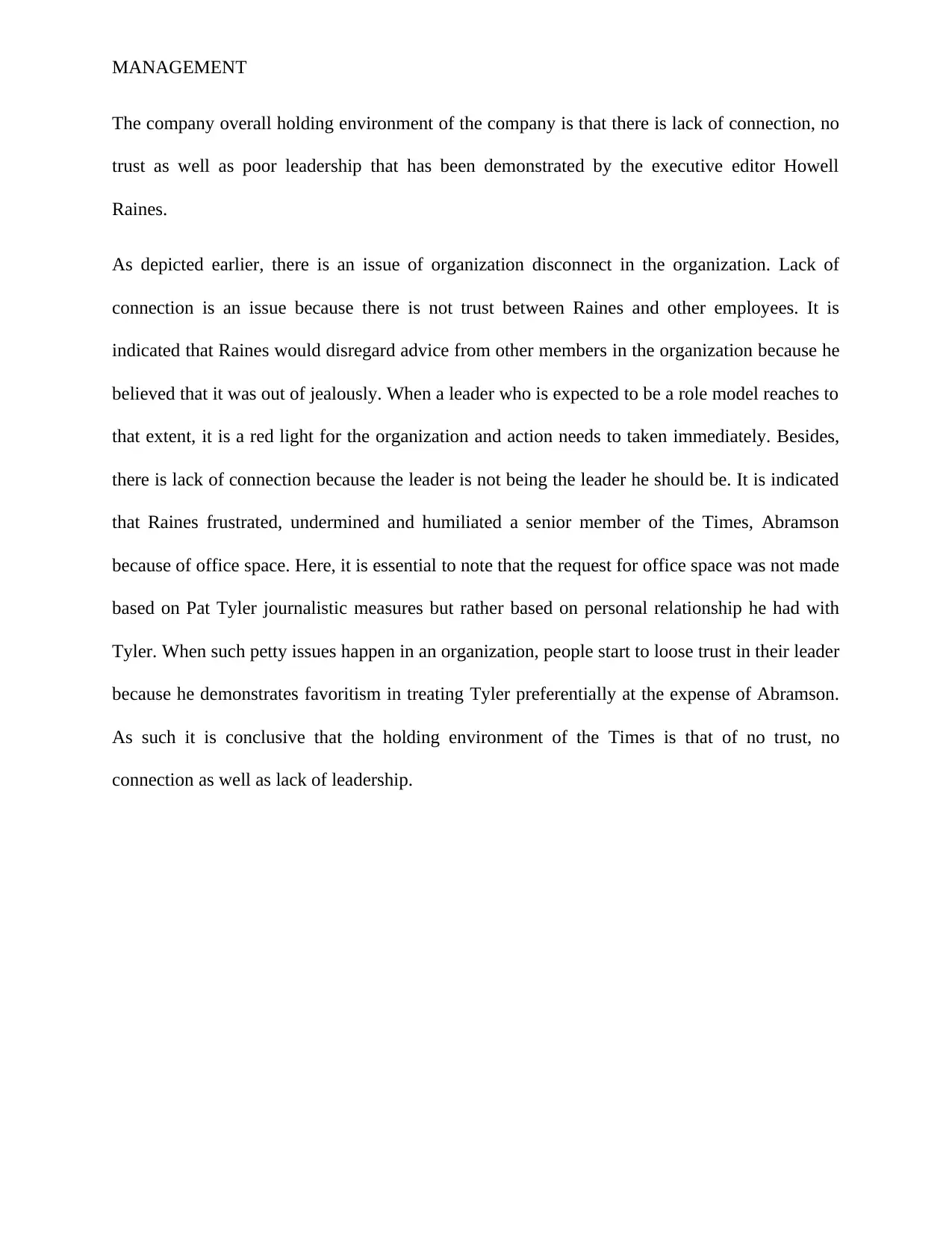
MANAGEMENT
The company overall holding environment of the company is that there is lack of connection, no
trust as well as poor leadership that has been demonstrated by the executive editor Howell
Raines.
As depicted earlier, there is an issue of organization disconnect in the organization. Lack of
connection is an issue because there is not trust between Raines and other employees. It is
indicated that Raines would disregard advice from other members in the organization because he
believed that it was out of jealously. When a leader who is expected to be a role model reaches to
that extent, it is a red light for the organization and action needs to taken immediately. Besides,
there is lack of connection because the leader is not being the leader he should be. It is indicated
that Raines frustrated, undermined and humiliated a senior member of the Times, Abramson
because of office space. Here, it is essential to note that the request for office space was not made
based on Pat Tyler journalistic measures but rather based on personal relationship he had with
Tyler. When such petty issues happen in an organization, people start to loose trust in their leader
because he demonstrates favoritism in treating Tyler preferentially at the expense of Abramson.
As such it is conclusive that the holding environment of the Times is that of no trust, no
connection as well as lack of leadership.
The company overall holding environment of the company is that there is lack of connection, no
trust as well as poor leadership that has been demonstrated by the executive editor Howell
Raines.
As depicted earlier, there is an issue of organization disconnect in the organization. Lack of
connection is an issue because there is not trust between Raines and other employees. It is
indicated that Raines would disregard advice from other members in the organization because he
believed that it was out of jealously. When a leader who is expected to be a role model reaches to
that extent, it is a red light for the organization and action needs to taken immediately. Besides,
there is lack of connection because the leader is not being the leader he should be. It is indicated
that Raines frustrated, undermined and humiliated a senior member of the Times, Abramson
because of office space. Here, it is essential to note that the request for office space was not made
based on Pat Tyler journalistic measures but rather based on personal relationship he had with
Tyler. When such petty issues happen in an organization, people start to loose trust in their leader
because he demonstrates favoritism in treating Tyler preferentially at the expense of Abramson.
As such it is conclusive that the holding environment of the Times is that of no trust, no
connection as well as lack of leadership.
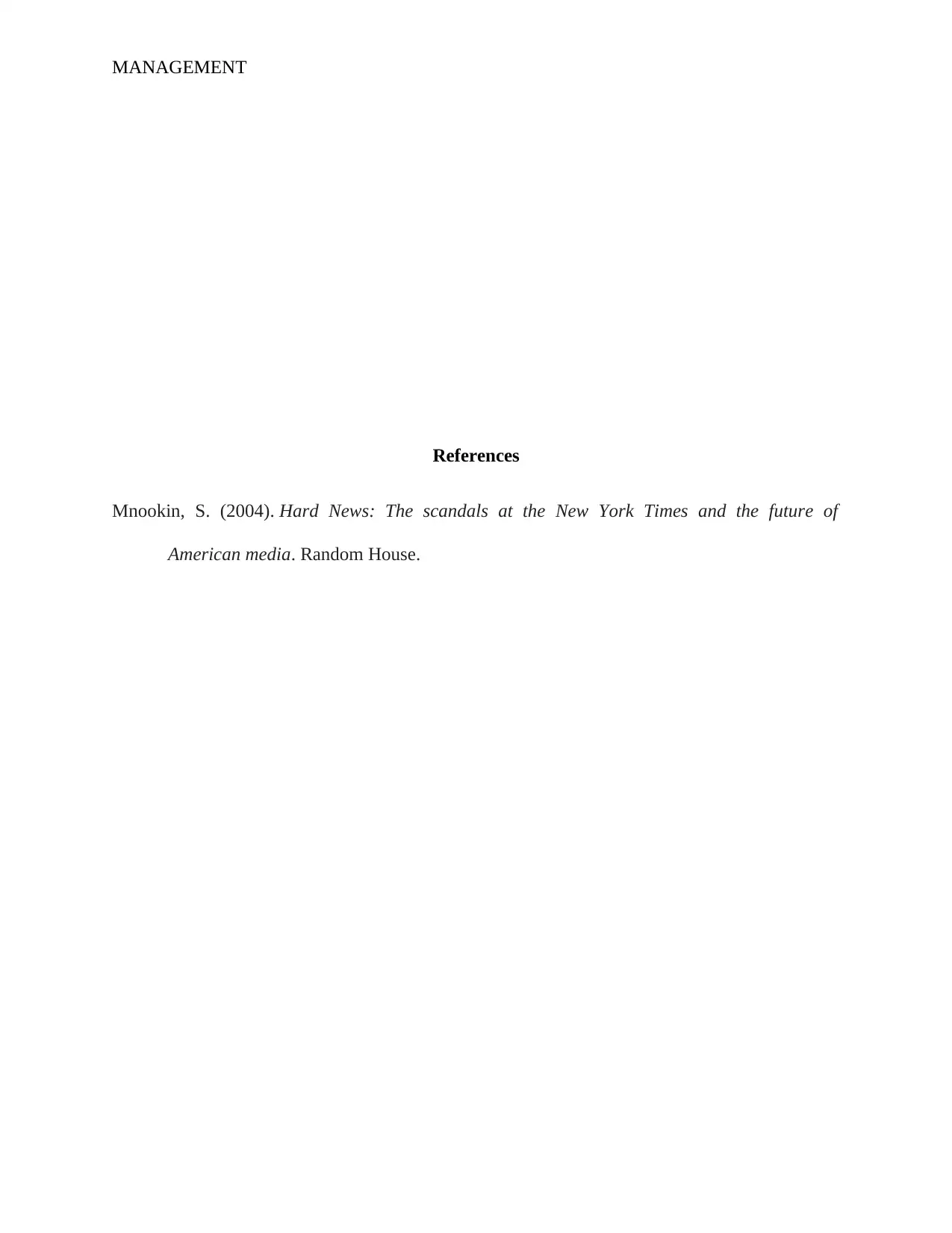
MANAGEMENT
References
Mnookin, S. (2004). Hard News: The scandals at the New York Times and the future of
American media. Random House.
References
Mnookin, S. (2004). Hard News: The scandals at the New York Times and the future of
American media. Random House.
1 out of 12
Your All-in-One AI-Powered Toolkit for Academic Success.
+13062052269
info@desklib.com
Available 24*7 on WhatsApp / Email
![[object Object]](/_next/static/media/star-bottom.7253800d.svg)
Unlock your academic potential
© 2024 | Zucol Services PVT LTD | All rights reserved.